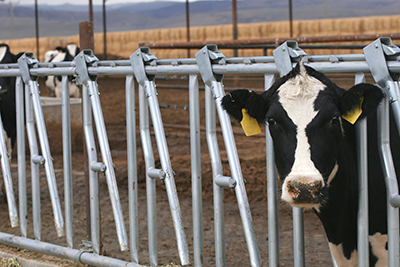Keys to protect cattle being shipped:
Established health protocols and communication
By Dr. Chris Schneider
Larger dairies increasingly ship cattle to another facility to be raised.1 Without established health protocols, this can significantly increase the possibility of disease introduction, especially for calves that are comingled with cattle from other dairies. According to the U.S. Department of Agriculture, most large operations (62.8%) sent heifers to an off-site raising facility as preweaned calves.1
A well-designed immunization plan and breeding
protocols – along with good communication – between the dairy farm and the heifer raising facility are crucial to prepare heifer calves for successful breeding and milking performance, and improve the health of their offspring to protect the future of the dairy.

Providing adequate maternal antibodies contained in colostrum is the first step in getting neonatal calves off to a healthy start. The second step: an intranasal vaccine that avoids interference from maternal antibodies in colostrum that can block injectable vaccines2 – and protects against the most common pneumonia-causing bacterial and viral pathogens.
BOVILIS® NASALGEN® 3-PMH is administered directly to the mucosal surfaces – which are loaded with immunologically-active tissues – it helps close the window of susceptibility to disease from birth to weaning. Intranasal vaccines provide protection early on, and calves develop both a serum and mucosal antibody response within two weeks of vaccination.3 Depending on disease pressure, a booster dose may be required.
Prior to breeding when heifers are 6 months old, they should be vaccinated with a minimum of two doses of a five-way modified live virus vaccine such as BOVILIS® VISTA® L5 SQ to protect against Infectious Bovine Rhinotracheitis (IBR), Bovine Virus Diarrhea (BVD) Types 1 and 2, Parainfluenza-3 and Bovine Respiratory Syncytial Virus, along with Leptospirosis. Diseases like IBR, BVD and Leptospirosis can cause early embryonic death, congenital defects and abortions.
If heifers are scheduled to return to the dairy farm shortly before they calve, a scours vaccine such as BOVILIS® GUARDIAN® should be administered 12 weeks pre-calving. This is generally followed by a booster dose three to six weeks later.
Calf scours is responsible for 56.4% of mortality among pre-weaned dairy calves.4 Only dam scour vaccines protect calves against all four major disease-causing pathogens and eliminate the need to vaccinate individual calves.5
Last but not least, communication is key between dairies, their veterinarians and the heifer raising facilities. Communication makes it easier to optimize the selection of animals for the breeding program. Regularly scheduled reports should address successes and concerns, and cover topics such as medical interventions and biosecurity protocols.
Before animals return to the farm, transport vehicles and pens should be disinfected. To protect against unnecessary stress on the animals, avoid unnecessary stops during transport and ensure staff members utilize low-stress cattle handling techniques keeping animals calm upon arrival.
Heifers should be placed in a clean pen away from other animals. Ideally, shipped heifers should be quarantined for 30 days before comingling with other animals to prevent disease spread.
References
- USDA. Dairy 2014, “Dairy Cattle Management Practices in the United States, 2014” USDA-APHIS-VS-NAHMS. Fort Collins, CO. 2016. #692.0216.
- Chase C., Hurley D., Reber A. Neonatal immune development in the calf and its impact on vaccine response. Vet Clin North Am Food Anim Pract. 2008;24(1):87-104.
- Todd, J.D., Volenec, F.J., Paton, I.M. Interferon in nasal secretions and sera of calves after intranasal administration of avirulent infectious bovine rhinotracheitis virus: association of interferon in nasal secretions with early resistance to challenge with virulent virus. Infection and Immunity. 1972. 5:699-706.
- USDA. Dairy 2014, “Health and Management Practices on U.S. Dairy Operations, 2014” USDA-APHIS-VS-CEAH-NAHMS. Fort Collins, CO. 2018. #696.0218.
- Arnold, M. Scours vaccine – give it now for protection in the spring. Ohio State University. Ohio BEEF Cattle Letter. 2016. https://u.osu.edu/beef/2016/11/30/scours-vaccine-give-it-now-for-protection-in-the-spring/. Accessed July 7, 2020.
Find more content for your dairy operation.
About the author

Dr. Chris Schneider, D.V.M., M.S.
Livestock Technical Services, Merck Animal Health
